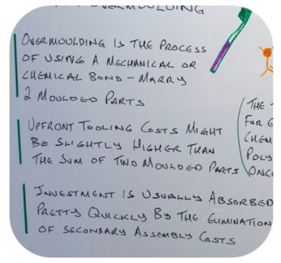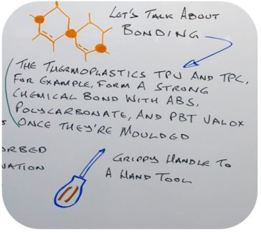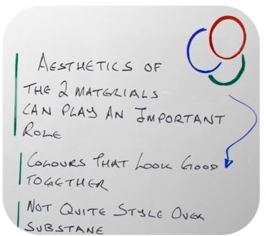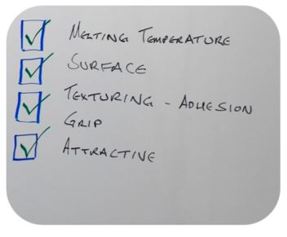Overmoulding
Your masterclass in product design and development
Protolabs’ Insight video series
Our Insight video series will help you master digital manufacturing.
Every Friday we’ll post a new video – each one giving you a deeper Insight into how to design better parts. We’ll cover specific topics such as choosing the right 3D printing material, optimising your design for CNC machining, surface finishes for moulded parts, and much more besides.
So join us and don’t miss out.
Insight: Overmoulding - Key Elements To Consider
Transcript
Hello and welcome to this week’s insight.
This week we’re looking at three of the key elements you need to consider when designing a part for overmoulding.
If you haven’t run into the term before, overmoulding is the process of using a mechanical or chemical bond to permanently marry two injection moulded parts together. It’s great for adding grips or handles to parts, and allows us to sidestep screws, glue and often assembly altogether.
The process involves taking a previously moulded part – the substrate – and putting it back into the press. We than inject a second plastic (or liquid silicone rubber) over, into and around the original part. When it’s all finished, we don’t have two separate parts, but one.

Just to make it clear from the start, because it’s more complex than standard injection moulding, the upfront tooling costs might be slightly higher than the sum of two moulded and assembled components. However, any additional investment is usually absorbed pretty quickly by the elimination of secondary assembly costs. And it gives you a higher quality, more durable product.
This all means that overmoulding is an incredibly useful process, but there are three main design considerations we need to bear in mind when we’re using it.

First, we need to think about the bonding itself, which needs to be as strong as possible.
Second, the materials. The substrate and overmould need to be physically, chemically, and thermally compatible.
Finally, there’s a few design principles we need to keep in mind. The principles of mouldability apply equally to overmoulding, with a few additional considerations on top.
Right. Let’s talk about bonding.

In a perfectly overmoulded part we want the parts to be chemically bonded together. The overlay should be impossible to remove, and will tear before separating from the substrate, or even take some of the underlying material with it. We can achieve this in quite a few ways. The thermoplastics TPU and TPC, for example, form a strong chemical bond with ABS, polycarbonate, and PBT Valox – once they’re overmoulded they aren’t going to separate again.
Achieving a high-level chemical bond isn’t always possible, of course, but fortunately the bond doesn’t always have to be a strictly chemical one.
Sometimes the design itself can lock the overlay in place – think of a moulded electronics housing cover with an overmoulded gasket made of a soft sealing material. Once the cover is locked in place, the gasket has nowhere to go. All that’s needed is enough bond to hold the gasket to the substrate so it can’t fall out or be misplaced during assembly.
This leads us neatly to talk about maximising your material choices. There are a few things to consider here, beyond the usual considerations of strength and general physical properties. Yes, we usually want the overlay to be nice and strong, but often we also want it to make a good grip.
One of the most common uses of overmoulding is to attach a nice grippy handle to a hand tool, whether that’s a drill or a piece of surgical equipment, so you want something with a good texture. TPU over ABS is an excellent choice for this.

As odd as it first sounds, the aesthetics of the two materials can also play an important role. Quite often you want the substrate and overlay to look nice when the overmoulding is finished, so they need to be in colours that look good together. In fact, many companies want to use plastics that match the branding on their logo.
Not quite style over substance, but sometimes it comes close.
One little tip is about making sure you stick to basic principles.
As with any other design process, overmoulding has a few guidelines that help everything run smoothly. Some of these are pretty obvious, some less so, but all of them are important to consider throughout the entire design process – you don’t want to be making 11th hour corrections on a job you thought was almost finished.

On the very basic level, you want to make sure that the melting temperature of the overmoulding material should be less than that of the substrate. You don’t want to be applying a handle to a ball of molten plastic, after all.
Another principle that always seems obvious in hindsight is that the surface of the overmoulded part should be even, with or slightly below any adjacent substrate surfaces, otherwise it’ll stick out and could be damaged.
Finally, texturing: Texturing of the substrate workpiece may help with adhesion. Texturing of the overmoulded part may provide a better grip and a more attractive surface.
Right that’s it for this week. I look forward to seeing you again next Friday.
With special thanks to Natalie Constable.












